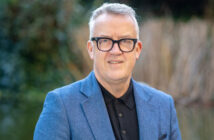The competition to design the new 5G Innovation Centre drew strong international competition when the University of Surrey received funding of £35 million last year to develop and fund the project. The funding for the project comes from a variety of sources including the Higher Education Funding Council for England (HEFCE) government and a range of corporate sponsors from the mobile communications industry.
Scott Tallon Walker’s concept for the new building creates a flexible space with a circular atrium that acts as a central lung and focus, to ensure maximum interaction amongst researchers. This ability to have both staff and students interact easily is a key element in the success of the design.
When built the scheme will achieveBREEAM ‘Excellent’ environmental rating using mixed mode, naturally ventilated, simple yet sophisticated energy concept for its ventilation. The materials used in the building are a pallet of low energy and maintenance elements including terracotta rain screen, aluminium, glass and steel, sympathetic to the adjoining buildings on all sides.
Professor Rahim Tafazolli, the Director for the new centre at the University, said: “It’s an exciting vision of what promises to be a very important centre for not only the University but for the whole of the UK and beyond.”
Peter Dudley, Scott Tallon Walker’s Director of Science and Technology, commented, “Our concept for this building was informed very much by how our own architects work. We see the new centre at the University of Surrey as a place where some of the finest minds in mobile communications from around the world will be sharing their visionary ideas. Our team has watched and studied how creative groups share ideas in the workplace and our design will mean that people will have a strong sense of contact, visual and/or aural, with colleagues during the working day. This leads to better collegiality but more importantly to the sparking of creative ideas, spurring people on with fresh suggestions while seeing the progress being made by colleagues. The Scott Tallon Walker practice is obviously delighted to have won such a prestigious competition but my colleagues working on the project are equally excited as they really want to see their ideas for this creative community in action.”
The research centre will accommodate both the university’s own researchers and those of its industry partners who will come and research at the university. Part of the overall proposal includes a test bed on campus, using lampposts as mobile signal base stations, that cover an area of four kilometres squared which will be used for demonstrations and proofs-of-concept.
The university’s Vice Chancellor Professor Sir Christopher Snowden, in announcing the scheme stated that,“The new 5G Centre will enable the UK to lead this rapidly expanding segment of the global digital economy. Locally, it will bring yet more momentum to the clusters of established and new high tech businesses on our Surrey Research Park. Finally, and very significantly for us, it consolidates the leading position of our own Centre for Communication Systems Research in Europe and paves the way for the further development of our long-term strategic partnerships with major global telecommunications organisations and significant inward investment into both Surrey and the UK.”



